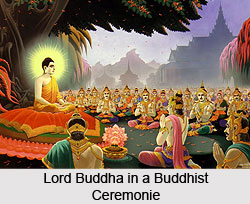 Theravada is one of the branches of Buddhism. This Theravada school is derived from the Vibhajjavada group, which has its origin in the older Sthavira group. It came into existence during the rule of Emperor Ashoka at the Third Buddhist Council. After a certain point of time Vibhajjavada broke up into 4 classes--Mahisasaka, Kasyapiya, Dharmaguptaka and the Tamraparniya. Theravada Buddhism evolved from Tamraparniya. It means the Sri Lankan descendant. This name was given to this school in India. The origin of this doctrine is till date unchanged. There is no historical evidence that there was any change from the original doctrine. The only difference is geographical.
Theravada is one of the branches of Buddhism. This Theravada school is derived from the Vibhajjavada group, which has its origin in the older Sthavira group. It came into existence during the rule of Emperor Ashoka at the Third Buddhist Council. After a certain point of time Vibhajjavada broke up into 4 classes--Mahisasaka, Kasyapiya, Dharmaguptaka and the Tamraparniya. Theravada Buddhism evolved from Tamraparniya. It means the Sri Lankan descendant. This name was given to this school in India. The origin of this doctrine is till date unchanged. There is no historical evidence that there was any change from the original doctrine. The only difference is geographical.
Vibhajjavadins consider themselves a part of Sthaviras. Sthaviras were an orthodox group and were often referred to as The Elders. Even after the Third Council they continued to call themselves Sthaviras or Theras. Though the doctrines are similar to those of the older Sthaviras they are not identical. The basic difference between Sthaviras and Theras lie in their language medium. In ancient India those schools that used Sanskrit as the medium to educate is called the Sthavira. The schools that followed Pali language were the Theras. But in essence both the schools followed similar doctrine. It was not before the 4th century that the term Theravada was used in written form.
According to the Singhalese tradition Mahinda brought Buddhism to Sri Lanka for the first time. Mahindra the son of Emperor Ashoka, the greatest Buddhist follower ever. As a part of missionary activity the principles of Buddhism arrived here in the 3rd century BC. Mahavihara Monastery of Anuradhapura was also established by Mahindra at this time. Later the monastery became divided into other groups. And were set up in according to their names--the Mahavihara, the Abhayagirivihara, and the Jetavanavihara. In the year 1164 the Sri Lanka King reunited all Bhikshus with the help from two monks in Sri Lanka. Thus the Mahavihara School was established.
Ashoka` s daughter, Sanghamitra, was the person to start the first nun order in Sri Lanka. But soon it lost its popularity. In the year 429 on the request of the emperor of China Han Dynasty a nun from Anuradhapura was sent to China to establish a similar nun order. Soon it spread to Korea. In 1996 eleven nuns from Sri Lanka were selected and ordained as bhikshunis by some of the Theravada monks. A team of Korean nuns was also part of the ceremony. However there is disagreement over the validity of such ordinations. A branch of the Theravada vinaya authorities does not consider such ordination valid.
Theravada Buddhism also spread to Suvannabhumi. This place is located in lower Myanmar. Here the earliest dwellers were Mon and they are believed to be the followers of Theravada Buddhism. There are historical evidences that these groups of people were closely associated with Sri Lankans and South Indians. The Burmese were the first to adopt the Mon religion. Later the Thai also adopted this religion.
From here the principles of Theravada Buddhism traveled far and wide into the world.




















